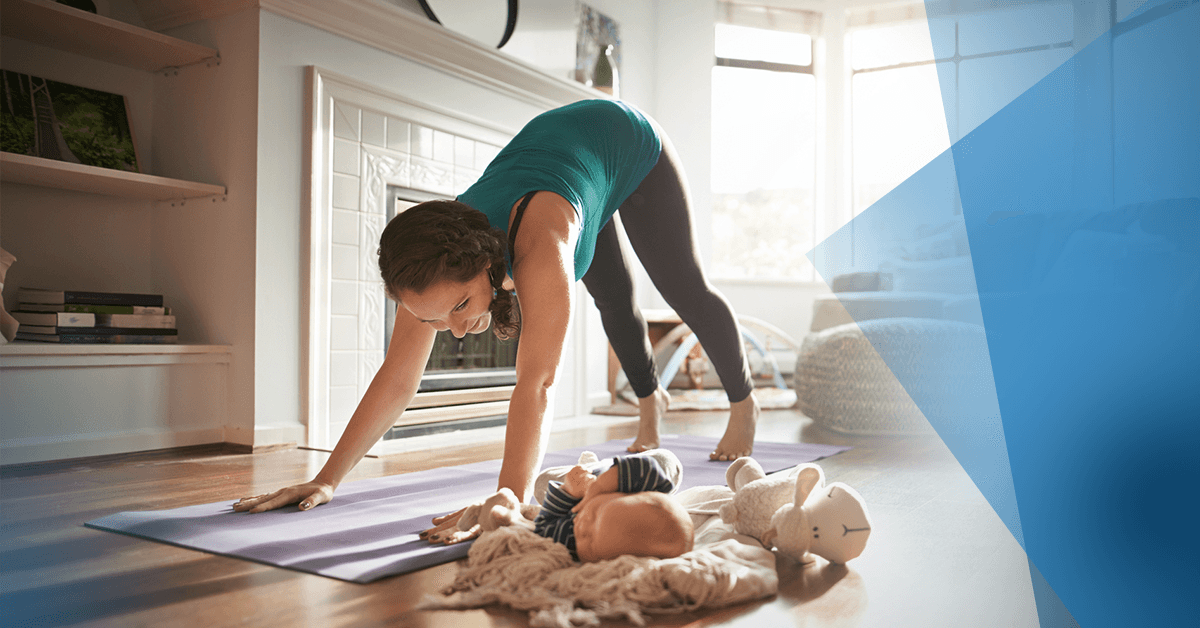I asked my new client to tell me her top three fitness goals.
“Well, as you know, I just had a baby six months ago,” she began. “So my biggest goals are to lose this baby weight and this poochy tummy, and to get rid of this lower-back pain.”
Then she added, with a chuckle of embarrassment, “And I guess to stop leaking every time I sneeze, cough, or jump.”
I asked if she’d ever had back pain or incontinence before giving birth to her son.
“Nope,” she said. Her friends told her it was all part of being a new mom, and she accepted it. “But honestly, it sucks!”
She got no argument from me on that last point. And I certainly understood why she was so focused on losing pregnancy weight and tightening up her midsection. It would’ve been easy enough to train her like any weight-loss client, which I’m sure she expected me to do.
But I knew that the back pain and incontinence she described, while common, weren’t normal. Nor was the bulge in her midsection. What new moms call a “pooch” can be a sign of a more serious problem known as diastasis recti abdominis (DRA).
I’ll explain more about DRA and incontinence in a moment. First though, consider this:
If one of your clients saw a physical therapist for tennis elbow or a severe ankle sprain, she’d come back to you with a series of prescribed exercises to strengthen the damaged area.
Even more important, you’d know what not to do. You’d avoid arm curls for the former and plyometrics for the latter.
That’s not how we approach postpartum training, despite the fact that pregnancy is one of the most challenging physical and emotional experiences any of your clients will go through. A new mom’s struggles and needs are very different from those of your other clients.
Let’s look at the specific challenges they’re likely to encounter.
Incontinence
About one in three women will suffer incontinence during pregnancy or after giving birth. Most simply accept it. They’ll wear a panty liner during exercise, if not daily, and wait for the problem to resolve itself while they focus on getting their pre-baby body back.
But as I said, it’s not normal. More importantly, it can be reversed.
Incontinence results from several factors unique to pregnancy and childbirth. First are the hormonal changes that occur during the nine months it takes to grow and carry a baby. Then, as the pregnancy comes to term, the weight puts a lot of pressure on the pelvic-floor muscles and surrounding organs, including the bladder, uterus, and bowels.
That intra-abdominal pressure, combined with the trauma of childbirth, creates pelvic-floor dysfunction, which often leads to incontinence.
The Fix
The core breath, as taught by Bellies Inc., is the simplest and best exercise to begin with. It retrains a new mom’s pelvic-floor muscles to fire appropriately when doing normal movements that put the bladder under stress, in or out of the gym. Proper firing will help stop unintentional urination.
Have your client sit on an exercise ball. Make sure she has proper postural alignment. Have her take a deep breath, expanding both her lungs and diaphragm, and perform a slow and controlled Kegel contraction. Then she forcefully exhales, as if blowing out candles on a birthday cake.
Relax the pelvic-floor muscles, and repeat.
Begin and end each workout with five to 10 core breaths until the problem is resolved, which will happen on a different timeline for each client.
Diastasis Recti Abdominis (DRA)
When my client talked about her poochy mummy tummy, she considered it a problem of excess body fat. But I knew it was a red flag for DRA, which is a separation of the linea alba, the vertical band of connective tissue that bisects the rectus abdominis muscle.
Every pregnant woman will experience some amount of DRA when her belly expands. But only a third of them will fully recover. The other two-thirds will have permanent separation to some degree, which can only be improved through more specialized programs.
You can see the difference between a mom who’s carrying extra baby weight and one with DRA with the assessment shown in this article. When I had my client do a partial sit-up, the loose flesh in her midsection popped up into a dome. The same thing happened when she did exercises on all fours, like bird dogs or planks.
That doming is a result of the separation between the two halves of the rectus abdominis.
The Fix
Your main focus is on strengthening key core muscles, including the multifidus, transversus abdominis, diaphragm, and pelvic floor.
These are my go-to exercises:
- Core breath
- Bird dog on a Swiss ball
- Dead bug
- TRX plank hold at a 45-degree angle
- Modified side plank, with knees bent
Pelvic Organ Prolapse
Normally, organs like the bladder, uterus, and bowel are held in place by the pelvic floor (sometimes referred to as the pelvic diaphragm). The floor has two gaps: one for the vagina and urethra, one for the anus. A prolapse occurs when the pelvic-floor muscles are weakened or damaged, and can no longer hold the organs in their proper place. Given the anatomical structure of the female body, organs can slip down into one of the gaps.
Pregnancy, labor, and childbirth are the biggest causes. A difficult delivery, or the normal delivery of a child with an unusually large head circumference, can create enough damage to result in a prolapse.
If it’s in the front wall of the vagina, the uterus or bladder might slip down. If it’s in the back wall, it might be the small intestine or rectum. Fifty percent of childbearing women will experience a pelvic organ prolapse, but many won’t know because the symptoms are often delayed. In either type of prolapse, clients can experience incontinence, constipation, pelvic or rectal pain, heaviness in the vagina or rectum (or both), the feeling that something is “falling out,” or the inability to hold a tampon.
The Fix
Unlike DRA, we can’t diagnose a prolapse. (A medical professional needs to perform an internal exam.)
But the exercises I already mentioned, starting with the core breath, will help strengthen the muscles of the pelvic floor without making the problem worse.
Training the New Mom
Let’s return to the idea of a postpartum client as someone recovering from injuries. Like any other rehab client, what you don’t do in your workouts is as important as what you include.
I wouldn’t do any of these exercises with a client who’s less than three months postpartum; is dealing with incontinence, back pain, or DRA; or has been diagnosed with a prolapse:
- Crunches and sit-ups
- Running
- Jumping
- Heavy strength training (more than two-thirds of her estimated one-rep max)
- High-intensity bootcamps or CrossFit-type workouts
If she’s more than three months postpartum, and has no symptoms at all (very rare), I train her as I would with any other client. If a symptom like incontinence emerges, or she develops back pain, I would modify the new-mom training program accordingly, starting and ending each workout with the core breath.
But if there’s one rule to follow above all else, it’s this:
While every postpartum client is different—the variations I see are incredibly vast—targeted, low-impact exercise is the safest and best approach for all new moms.
There’s plenty of time to get back into heavy, high-impact training. But if you rush it, there’s a very good chance your client will pay a price, now or down the road.










